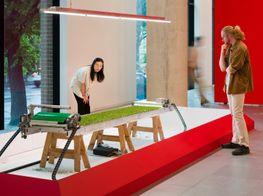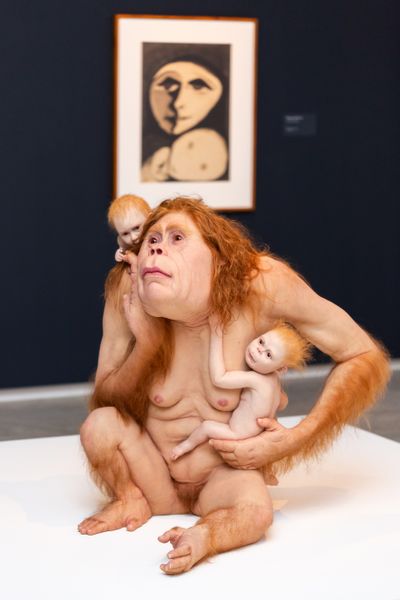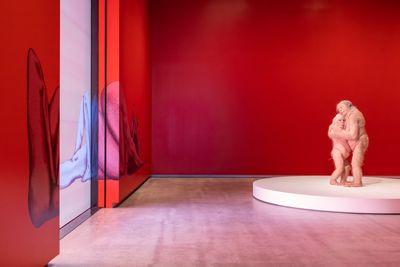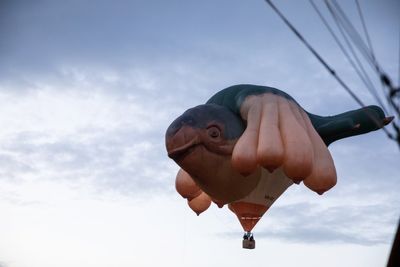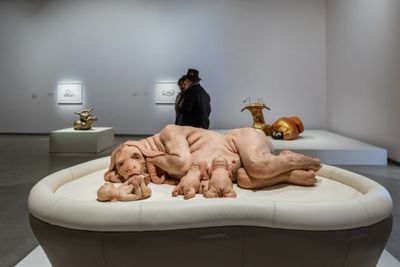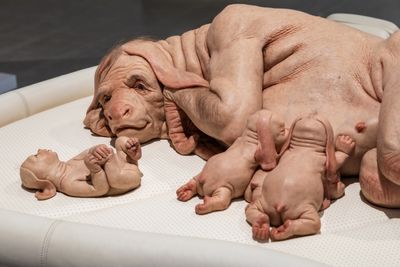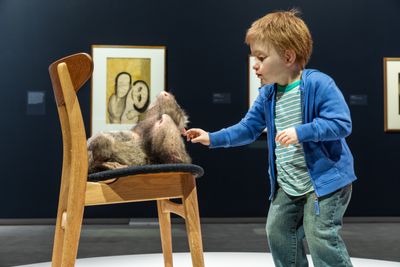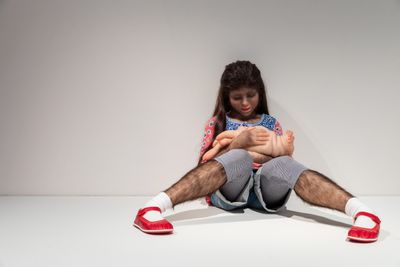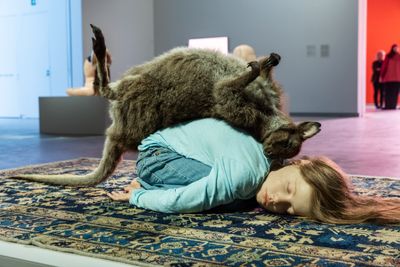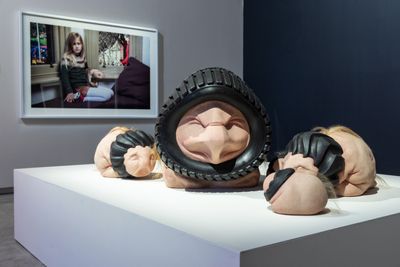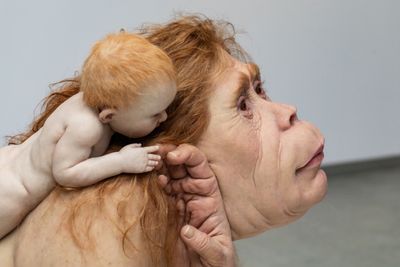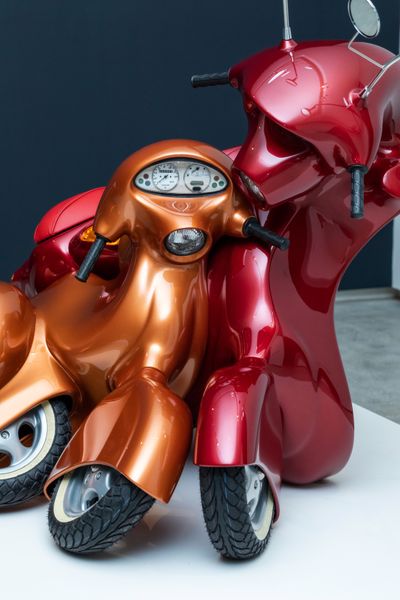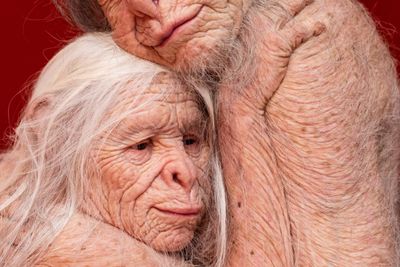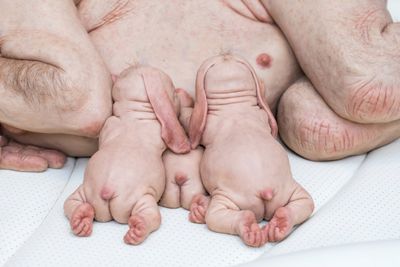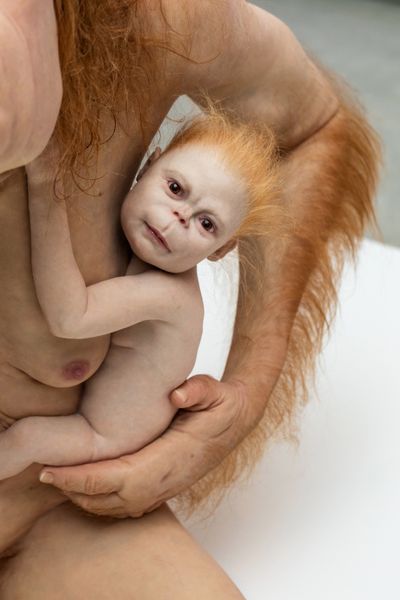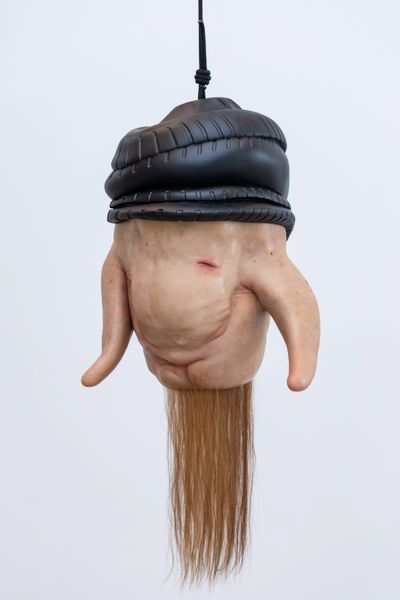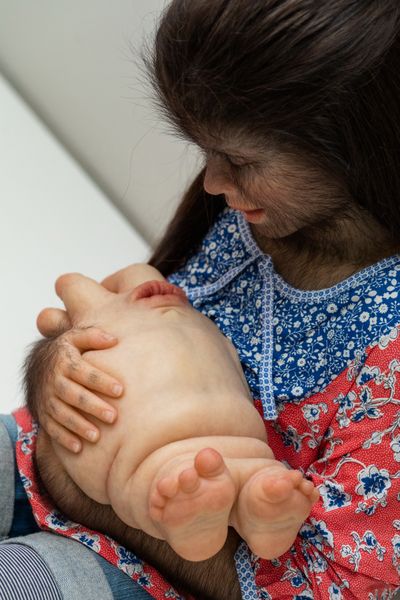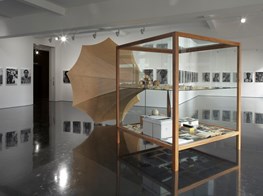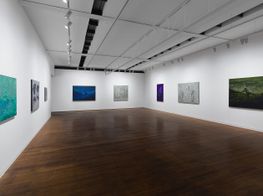Patricia Piccinini & Victoria Lynn
In collaboration with TarraWarra Museum of Art
Patricia Piccinini. Artwork: Patricia Piccinini, Sanctuary (2018). Exhibition view: _Patricia Piccinini & Joy Hester: Through love ..., _TarraWarra Museum of Art (24 November 2018–11 March 2019). Collection of the artist. Courtesy the artist, Tolarno Galleries, Melbourne and Roslyn Oxley9 Gallery, Sydney. Photo: Rick Liston.
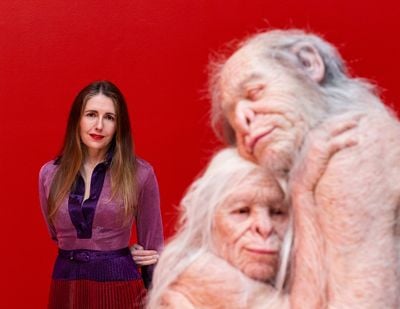
Patricia Piccinini. Artwork: Patricia Piccinini, Sanctuary (2018). Exhibition view: _Patricia Piccinini & Joy Hester: Through love ..., _TarraWarra Museum of Art (24 November 2018–11 March 2019). Collection of the artist. Courtesy the artist, Tolarno Galleries, Melbourne and Roslyn Oxley9 Gallery, Sydney. Photo: Rick Liston.
Patricia Piccinini & Joy Hester: Through love ... at TarraWarra Museum of Art (24 November 2018–11 March 2019) is an exhibition that reveals shared explorations of love, intimacy, and relationships in the work of two of Australia's leading artists. This is the first exhibition to explore the conceptual links between the works of Patricia Piccinini and Joy Hester, relating Hester's expressionistic ink drawings of blended identities to Piccinini's depictions of intermingled human, non-human, and hybrid forms.
For Hester, a member of Melbourne's 'Heide circle' during the 1940s and an artist whom Piccinini has admired throughout her career, these ideas appear in the exhibition through two series of works: 'Love' (1949), and 'Lovers' (1955-1956). Hester's powerful and fluent use of brush and ink show a man and woman unified in an expression of togetherness, so much so that their faces in the 'Love' series often share an eye, and yet, her works are underpinned with a sense of unease. As Hester remarked in a letter to Sunday Reed in 1947, 'how can I love [him] when he is me! ... He is the "man" of me and I am the "woman" of him ... we are part man, part woman ... It's like a puzzle, piecing oneself together ...'1
In Piccinini's internationally renowned contemporary practice, figures are brought together in several formations, often in the form of large-scale realistic sculptures. Many of Piccinini's depictions are hybrid, so that within the work is another fused coupling—whereby the figure has become a chimera, part human and part animal.
The following conversation is an extract from the exhibition's catalogue 'Patricia Piccinini & Joy Hester: Through love...' published by TarraWarra Museum of Art, Australia. The extract has been published in 'Ocula Magazine' in collaboration with the TarraWarra Museum of Art.
VL: This exhibition combines a selection of your sculptures, videos and photographs with the brush and ink drawings of Australian modernist artist Joy Hester. In particular, I have chosen work from two series, entitled 'Love' (1949), and 'Lovers' (1955–56). In the first series we see Hester's use of the intermingled figure, where two people are in such an embrace that they share an eye, a nose and/or a mouth. Through love, their identities become hybridised. In the later series, we see couples in various forms of embrace. The choice of Hester as a companion artist to exhibit alongside your work arose in conversation with you. Can you discuss your own response to Hester's work?
PP: I first saw Joy Hester's works while I was studying Economics at Australian National University. While I was trying to internalise a supposedly emotionless discipline that plots people's preferences on curves, Hester's work came bounding into my life and was probably part of the reason that I had the courage to eventually give up that path in life. I saw these images of people blending together, showing a love so strong that the space between one person and another disappeared. To me it was so beautiful, so moving. Especially at a time when I was starting to think about what it felt like to be connected to someone outside of my family.
It was the early eighties and part of this time was me looking for Australian women artists. There seemed so few but Janine Burke's book on Hester had just come out, and here was one that I could really relate to. Another part of it was the emotional weight and content of Hester's work. I love the way that her painting, especially those with merged features, are simultaneously surreal and figurative. I am really interested in depictions of love and intimacy in my own work, so I find Hester's approach very inspiring. I think my practice still owes a lot to her work, if you look at a work like Joined Figure (2016), it is easy to see this.
Locating my work next to Hester's creates a very interesting context for it. It really shifts the social reading towards the emotional register which is very much how I intend it. However, this is not always the audience's first interpretation—they often see it as a precautionary tale about science—so I'm really excited to contextualise in this way.
It feels amazing to have come full circle, I would never have imagined as a young twenty one year old student that I would one day exhibit alongside this great artist.
VL: In her book, Janine Burke discusses the various influences on Hester: her use of the protruding eye owes something to Jean Cocteau's drawings for Opium (1930) which she read around 1946. Hester's images also exhibit the influence of Edvard Munch and Pablo Picasso's Guernica (1937), particularly in earlier works than those in this show, which show the female head thrown back as it were, in either ecstasy or anxiety. Moreover, she was probably also exposed to the work of Emile Nolde, through the library at Heide, in particular an untitled watercolour reproduced in Herbert Read's Art Now (1936) displaying two shadowy figures facing one another.2 There is evidence, too, that she saw the horrifying images of Holocaust survivors in the wake of WWII. Hester's work exhibits characteristics that could be called expressionistic, with her use of protruding eyes, freely brushed areas of ink, and the use of intense lights and darks. How important do you think expressionism is in your own work?
PP: Many people wouldn't know it, but expressionism was a really formative influence for me. The paintings that I brought to my art school interviews were expressionistic depictions of women that owed probably too much to Hester. They were pretty derivative actually, I freely admit. Thirty years later, my work looks really different, it's quite technically refined but the unabashed emotionality of expressionism is something I have not lost. It's one of the important layers of the work and I'm quite comfortable with that.
VL: The degree of expressionist anxiety in Hester's images casts the idea of love and lovers in a way that may be distinguished from conventional understandings of romantic 'love'. Despite being analogous to the hybrid creations of science fiction—which can produce images of horror and fear—the creatures in your works seem to be very much at home, comfortable in their skin. Despite their unconventional forms, there is a sense of contentment. Some respond to your work with a sense of anxiety, and the works have been compared to the idea of a monster. In fact, you are interested in Mary Shelley's Gothic novel Frankenstein; or, The Modern Prometheus (1818), in which a scientist creates a monster. What interests you about this story?
PP: I am so interested in Mary Shelley and her story. It's the 200th anniversary of the publication of Frankenstein this year, and the more I've been reading around her life and work the more fascinated I've become. For me Frankenstein is a story about bad parenting. Dr Frankenstein creates a being that is unique but neither traditionally beautiful nor truly human and for these reasons he despises it. Instead of loving and caring for his creation—essentially his child—he rejects it and the whole tragedy of the novel, the violence and despair, all hinges on this action; this relationship to difference and beauty.
I'm interested in this question: what are our responsibilities towards the new life that we create and change all around us? My work begins with the premise that we have a deep duty of care and asks questions about the ethical issues that flow from creation of any kind. Will we love our 'failures' as much as our 'successes'?
However, while the monster is considered a failure by Frankenstein himself, to me the monster is the character that we can most empathise with. He stumbles away from his birth, naked and without language. He is so vulnerable. He has to hide from the villagers who recoil in horror when they see him. He learns about love from a family that he monitors from a spy-hole in their shelter. When the monster asks for a mate that he can share his life with and experience love, Frankenstein reluctantly starts to build her but then eviscerates her in front of the monster's eyes when he comes to collect her. For me, this is the ultimate form of malevolent control; denying love in someone else's life, a basic human right, in fact a physical need. And Shelley weaves all these intricate relationships together alongside other major themes like the hubris of mankind to even imagine that we, through science, can control nature. It's a brilliant novel.
In some ways this is what I try and do with my work; weave together ideas around how we relate to difference and connection in the context of an environment where we now know that we are closely, genetically related to every other living animal on this planet and at a time when we are most able to fundamentally change the genetic make-up of our being. You could say that my creatures are often a bit like Frankenstein's monster; they have a push/pull thing going on. They push you away with their unfamiliar, sometimes unattractive appearance but then they pull you in with their positive depictions of fortitude or vulnerability. When this happens, a space opens up in the viewer, a space to arrive at their own conclusions and the potential for meaning-making appears.
VL: When you talk about 'failure' what do you mean? Is it as broad as a failed art work, an imperfect human being, a deformation or mutation? Does your work sit on an edge of perfection and imperfection.
PP: I guess when I say 'failure' I mean something that doesn't conform to whatever has been defined as the desired outcome, usually it is what is most useful for humans. By presenting scenarios, installations or sculptures as seen through the eyes and experiences of other creatures—even if they are mythological—we can question the assumption that success is what is useful to people.
I shy away from words like 'deformation' or 'imperfection' as they suggest there is some sort of perfect or ideal form that should be sought out. I really dislike this idea. I embrace diversity of all forms, in fact I sometimes worry that technology is making the space for difference smaller when it could be making it bigger. Obviously, there are some physical conditions that make life much more difficult for those that carry them, but that is because the world is not set up to accommodate them. It doesn't make them abhorrent in themselves.
VL: Frankenstein has engendered many science fiction films and I wonder if science fiction is an interest of yours?
PP: Not especially, however there are some artists within the genre of science fiction that I'm very interested in. I'm thinking of the works of Octavia Butler or David Cronenberg for example. However, the work I like tends to use the genre in a double way, to simultaneously discuss difficult ideas about the world, and to couch those ideas in a form that is accessible. Octavia Butler takes sci-fi and uses it to write intensely political books about race and gender that nevertheless reach an audience that is looking for entertainment rather than education. That is something that does interest me.
VL: Love and intimacy are important themes in this exhibition. In particular, there are three distinct bodies of work: mother and child; child and animal; inanimate and animate objects. Each is engaged in an intimate relationship with the other. Moreover, there is a further doubling, if you like, in the fact that many of your figures are themselves hybrid or blended forms, between human and animal. Can we first discuss the theme of mother and child in your work? Skywhale (2013), is the mother figure, while the examples of mother and child in this exhibition include, The Young Family (2002), Nest (2006), Thicker than Water (2007), Kindred (2018) and to a degree, Plasmid Region (2003). It is of course an historical subject matter in art history. In this exhibition are two works by Hester that depict the mother with a child. In Mother and Child (1955), the mother's face is in shadow on one side, and in the light on the other, to signal a complexity in motherhood. In Mother and Baby (1955), the stalk-like eyes of the mother reach down towards the infant, in an expression of both care and fierce protection. Are there any artists in particular whose work explores this theme that you are also drawn to?
PP: That is all true. However, while maternity is represented in art history with images of the Madonna and child, it is not something you see a lot of in contemporary art and culture. When I present a maternal relationship I think the first thing I do is valorise it. I think this is an important thing to do at this time when we are struggling to redefine gender roles and—through science—we are also understanding the vital significance of a primary carer (regardless of sex) when it comes to nurturing children and getting them able to form stable attachments in later life.
Also, for me, the image of the mother and child is not about a restating of the socially appropriate roles for women as it often is in depictions of the Madonna or even the nineteenth century social realism that I am often drawn to. For me, the mother and child relationship is a celebration of the beauty and power of maternity and of the fecund female body. I don't think my mothers are constrained or restricted by their maternity. Their ability to create life is their power. They are literally awe-inspiring.
I was just reading about the placenta. This is a completely new 'organ' that the mother grows but that is half composed of genetic material coming from the father. Yet, it is accepted by both the mother's body and the foetus. If we can understand how it does this we can maybe go on to use this to prevent organ rejection in transplant patients. And conceptually, it is this amazing example of coexistence and cooperation.
As I mentioned, I do find myself drawn to nineteenth century social realism, especially depictions of the plight of women and children. At around this time, there also emerges the use of animals to tell similar emotional stories. One of my favourites is August Schenck's Anguish (c. 1878) which is in the National Gallery of Victoria collection and depicts a mother sheep mourning her dead lamb, surrounded by a murder of crows, whose presence I feel is far more ambiguous than threatening. I love the strangely dramatic emotion of this painting, and I feel that it is actually less 'anthropomorphic' than we might have thought. We now know that mourning the loss of a child is very common across many animal species, including us. The painting is very much one of the original inspirations for my Vespa sculptures.
VL: Like the Schenck painting, there is a strong sense of narrative in your work. As you say, the depiction of motherly care and love in works such as The Young Family is not a restrictive role for the mother figure, but rather a more expansive notion of trans-species form of care. Can you discuss this seminal work in more detail?
PP: This was the first work I made that really had an impact on the world stage, and looking back at it, the work still encapsulates so many of the key issues of my practice: difference, empathy, maternity, technology. It is a work inspired by science—the use of other animals to generate human replacement organs—but it is a work that is animated by emotion—the love of a mother for her children. It was inspired by the idea that we might engineer creatures that could be used to grow replacement human organs, possibly human-pig chimeras. It seems a simply positive proposition, but I am interested in how even the simplest possibility can be ethically complex. This is the dark dilemma that gives the work its spine: how would it feel if you had to end her children's life to save your own?
VL: What of the theme of child and animal? What is it about this special relationship that so captivates you? What do you think happens when the child takes on features of the animal? Examples in this exhibition include, The Comforter (2010), The Fitzroy Series (2011), Doubting Thomas (2008), and Balasana (2009).
PP: I often depict children in the work because they represent potential. They have not yet developed the biases of adults. We can imagine that their hearts are open in the face of difference. In The Fitzroy Series we see many different connections between humans and new and unnatural life modelled for us in a potentially realistic way.
Children also bring out the best in us, we can empathise with them, and in my work they highlight our unease with new technology when we see them so close to unnatural creatures. In Doubting Thomas, our concern as the child reaches his little hand into the creature's pouch to touch her babies is opposed to his untroubled curiosity. The title refers to the often gruesome depictions of St Thomas touching the wounds of Jesus in order to be convinced of his divinity.
The figures of children are often where I depict what I guess you could call 'traditional' humans. However, as The Comforter shows, even within that definition there is quite a range of variability. That work portrays a young girl with hypertrichosis, a genetic condition that gives her a lot more hair than the average person. For me, it is telling that people often find her naturally occurring condition more disturbing than the artificial chimera she is holding.
The Coup (2012), is different again; this young fellow is a human/orangutan hybrid. We look at him and we can see that like any other teenager he is quite normal in that he seems uncontrollable. And yet we feel that as he is a technological man-made being we should be able to control him unlike the natural bird that he is about to interfere with.
VL: Can you also discuss Balasana?
PP: Balasana attempts to imagine a different sort of relationship between people and nature: one with a shared vision that is more equitable. At the same time, it is a work that refuses to accept the impossible naivety of such optimism. In this work we see both the girl and the wallaby at rest against each other, both relaxed and perfectly balanced.
VL: This would suggest that the divide between nature and culture, or animate and inanimate materials, is fluid. In this sense, there is no 'other', no binary opposites, but rather a more ethical turn that sees a continuum between nature and culture, human and animal. How is this expressed in the series of photographs entitled The Fitzroy Series?
PP: That idea is pretty much the heart of my work, so you could see it to a lesser or greater degree in everything I've done over the last 25 years. In The Fitzroy Series, I was looking at the rapid normalisation of new technologies in contemporary life; the way that something as extraordinary as IVF for example can be become so commonplace as to be unremarkable in just a few years. I see this as a sort of 'naturalisation' of the artificial, to the point that our idea of what is natural expands to incorporate so many things. In these photographs, I depict a world that is very familiar to me—my local neighbourhood of Fitzroy, my own children's school and friends—and introduce one new element, the man-made creature, that seems to fit in seamlessly without any disruption at all. The choice of the inner city is also deliberate, for this is both my own 'natural habitat' and also the most artificial environment imaginable. My question is: are the trees that are planted there artificial or natural?
VL: The third body of work, and often the most humorous in your oeuvre, is the intermingling of animate and inanimate objects, such as Joined Figure (2016), Atlas (2012), Nectar (2012), Ghost (2012), and The Seedling's Dance (2018). When I look at an image by Hester such as Love (I) (1949), the conjoined figure in your work comes to mind.
PP: These works belong to a group that express a very contemporary idea of the body and the organic as protean and ultimately malleable. In an era when we feel both enabled and entitled to change both our own bodies and those of the animals around us, the corporeal becomes both plastic and a resource to be shaped to our needs and desires.
So, there is that conceptual background, but these works also come very much from my drawing practice, from a way that I draw when I am developing works which is somewhat unconscious and quite influenced by surrealism. You are very right in pointing out the humour in these works, as I personally find them both beautiful and funny. In some ways, these are quite simply forms that I am attracted to.
VL: When one views your work, the level of detail is incredibly compelling. Skin is of course both porous and a barrier: it protects and it breathes. It can be wounded, and it can age. Skin is a marker of time and age. In Hester's work, skin is translucent, and the light shines from within. Skin can be in shadow, or bathed in light.
PP: Yes, that is a good point. Skin and hair are both really important aspects of the work. The level of detail is important to me, because I am trying to create an experience that doesn't 'break down' as you look more deeply. That's the thing about the natural world, you can always look more closely and see something else open up. Like the Powers of Ten films by Charles and Ray Eames.
Obviously I can't hope to reproduce the infinite complexity of nature in my work, but I do hope to emulate the experience where you see the work at a distance and understand it at a macro level, and as you get closer you see more layers—both physically and conceptually—until you are right up against it and you can see individual hairs and wrinkles. The point of all this effort is not to trick the viewer with verisimilitude but to hold them in the experience for as long as possible.
VL: One of your works in the show is entitled The Lovers (2011), and depicts intimacy between two machine-like creatures. The new work that you have made for this exhibition, Sanctuary (2018), based on the bonobo, is also an expression of intimacy and of embrace. Do you see a connection between the motor vehicle works and the animal/chimera works?
PP: Absolutely. In fact, I find it hard to see much difference between them apart from media. They really are dealing with many of the same ideas. The Lovers, and works like it, start from the position that technology has become so naturalised that we think of animals and machines in the same terms. A cow might be considered an organic component in a mostly mechanical milk production process, for example. We talk to our cars and our computers much as we talk to our pets. In The Lovers, we see machines imagined as wild—rather than domesticated animals—and this suggests an anxiety about technology escaping our control.
The chimera work is similar but the opposite in that it talks about how nature is becoming increasingly technologised. When we view the chimeras I present, they seem conceivable not only because they seem real, but we know that we are actually already changing nature all around us in fundamental ways in the real world.
VL: Can you discuss how you choose to work with a particular animal? For example, the new work uses the bonobo.
PP: I am especially enamoured of the endangered bonobos. We only recently realised that they were a separate species from chimpanzees, however we did know that they behaved quite differently from them. Bonobos seem to be a matriarchal society, far less violent than chimpanzees and they tend to resolve conflict through sexual connection rather than violence. They are the only other animal known to engage in tongue kissing and face to face copulation. Chimps and bonobos evolved from the same ancestors, but in very different environments. Bonobos evolved in an environment of plenty that supported sharing whereas chimps developed in a situation of scarcity that rewarded aggression and coercion. Obviously, it's not as simple a dichotomy as that but it's pretty close. In ourselves we can see the interplay of these forces and methods, and it makes me think of our common primate ancestors.
When I came to the new work for TarraWarra I knew I wanted to make something that celebrated our 'bonobo-ness'; a work about love and intimacy. I was also thinking about ageing and how we tend to desexualise adults as they age even though we know that our sexuality doesn't end but changes. I was thinking about love, and what it means. It is a fleeting moment of connection, but a continuum of these moments can create a lifelong relationship.
This is a very positive work, depicting intimacy and the positive moments of love we can feel when we physically connect with people. Traditionally we see these moments portrayed as the domain of the young, and I have recently made a work that looks at that. So, I was curious to see how this might look through the lens of older figures.
In my mind it made a certain kind of sense to bring together all of these ideas. As I said, it's very much a work about love and intimacy. But it's also very much a reference to Joy Hester's merged faces. I've been reading about love, and I have found this definition that really makes sense to me: Love is an experience where two individuals share a moment of positive emotion, biochemical connection and common sense of care. This experience can be shared by any two people. It's not about sex and it's not exclusive to partners or parents, it could be between strangers. I see this very much in Hester's merged faces, and I also feel it in our more positive primate selves. This work brings all that stuff together.
VL: Why animals? They seem the most at risk. In your chimeras I often wonder how they were produced, and if they would ever reproduce.
PP: That's an important point. The creatures in my work are often presented as both capable of—and engaging in—reproduction. In many ways, I'm less interested in which strain of science they could have emerged from—the fact that they reproduce is key to their agency. Reproduction gives them a degree of control over their future and that is very important to me.
Getting back to my interest in animals, obviously the animal I reference most often is humans. I come from a position that starts with the relationship between humans and other animals; that sees humans as a kind of animal. That is why, with my creatures, it is difficult to tell where the human starts and the other animal ends. Genetic research makes it really obvious that there is more connecting us to other animals than separating us.
VL: Can you discuss the work Kindred in which the orangutan nurtures her children?
PP: The idea that we, as humans, are uniquely and fundamentally different from other animals is at the cornerstone of how humans have traditionally thought of themselves. This belief of 'specialness' allows us to exploit the environment and other beings around us so completely. However, both genetic analysis and scientific observation is showing how small those differences actually are.
Like humans, orangutan mothers keep their children close, educating and nurturing them for many years (around six). In this work, the mother and her two children are all different from each other, each set at a different point on a continuum of greater or lesser animal-ness, her smaller child is almost completely human—although she does share her mother's hair and eyes.
If you spend enough time with the work, you come to the realisation that they are as different from each other as they are from us. However, the real point is that they are so totally connected to each other—a state that I admire—and this connection can extend to us. The mother's orangutan-like features also bring up the uncomfortable fact that her species is endangered from human habitat encroachment. However, she doesn't shame us, instead she looks at us with real integrity and beauty.
VL: The three drawings Poised Runner (2017), Guarded Entrance (2016), and Bridged Connection (2016), explore a surreal form of eroticism where the hair itself comes to life. Each of these works uses a bird. Why the bird? Is there a particular symbolism that you are looking at?
PP: In some ways drawing for me is so personal that it can take on erotic intimacies, but I'm interested in exploring new ways to do this that don't rely on traditionally patriarchal tropes.
I often depict birds because they seem so sensual to me. In many cultures and certainly western culture they tend to symbolise freedom and a free-floating spirituality. To me this goes hand in hand with the idea of the sensual body, perhaps a body that is not depicted just for its superficial beauty but one that is communicating what it might be like to 'feel' a kind of body awareness or arousal.
I often depict hummingbirds. They are pollinators and seem to exist in the world in the most inconceivable way, they beat their wings and hover and do the most intricate things in the most graceful way. They are full of wonder for me.
VL: In terms of your interest in the surreal, can you talk about some of the female surreal artists that interest you, e.g., Leonora Carrington, Remedios Varo, Jacqueline Lamba, Olga Costa, Cordelia Urueta, Kiki Smith and Louise Bourgeois?
PP: Yes, these are the artists I most identify with. Like them, I'm not particularly interested in depicting the real world. I'm more interested in depicting relationships between people and between people and other animals and the environment. Also like them, my world is seen directly through very feminine eyes.
VL: There has been a certain resistance amongst a younger generation of women to use the word feminism in relation to their creative work. I call myself a feminist, because I believe that women should have the same opportunities as men. This also applies to the equality of all genders, including LGBTQI+. Would you call yourself a feminist, and if so why?
PP: Yes, I would certainly say I'm a feminist. I think everyone has a vested interest in valuing women simply because we all come from a woman's body. You may not have the best mother in the world or you may not be interested in giving birth yourself, but you do come from a woman. I think a lot of the traits intrinsic to female bodies and experiences are pretty great but have a hard time finding a place in our society. Fundamentally, I'm a feminist because I love people. For me feminism is a positive impulse, it is about valuing the female, in all people. And not at the expense of anything else. It's not a choice. You don't need to diminish anything else to value the female.
VL: Finally, given that we are in the company of Joy Hester's work and poetry, may I quote one of her poems, entitled Heart (1949), which is replete with childhood memories of birds, wings, the heart and cries.
a bud, a bird, a golden box, gently packed within the heart,
wings of birds, grey and pink — wings of softest nature.
place me a heart upon my breast and beg my hands to soften,
collect me tears from childhood's howl, pick a bud — a deepening rose and
I will hear some birth-flowers' message —
beyond my eyes horizon — a moonewashed thought, put the
word within a box and take away the key.
Patricia Piccinini & Joy Hester: Through love ... continues at TarraWarra Museum of Art until 11 March 2019. The exhibition's catalogue 'Patricia Piccinini & Joy Hester: Through love...' published by TarraWarra Museum of Art is available from the Museum Shop for RRP$25, see twma.com.au.
—
1 Janine Burke, Joy Hester, Melbourne: Greenhouse Publications, 1983, pp. 84-89.
2 Ibid., p. 120.


